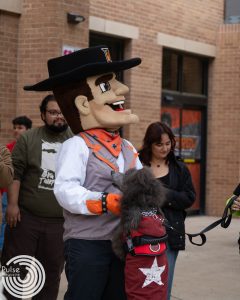The “A” Word: A Student’s Account of Her Abortion
In the UTRGV Student Union, there stood Carolyn Garcia, a smile on her face as she displayed a sign reading “free condoms!” in bubbly blue lettering. She wore a bright pink T-shirt in support of the Planned Parenthood Federation of America. Just like she backs them, the international reproductive health organization has assisted her and thousands of other women around the world by providing mammograms, birth control, and – the reason the group’s Medicaid funding was pulled by the Texas government in October – abortions. As several students read her sign and giggled at the thought of condoms, the 21-year-old couldn’t help but grow silently angry.
“Do you think STD’s are fun?” she recalled thinking. “[By using condoms] you don’t get pregnant, you don’t get the itchies and the life-threatening things.” She spoke from experience. When she and a partner had a drunken, unprotected encounter in the summer, it ended with
her at the post-procedure room of the Whole Woman’s Health clinic in McAllen. Her legs ached, feeling like she had just ran a mile. She cried, but she blamed it on the sudden change of hormones. Ten months later, she doesn’t regret having an abortion.
WITH A CAPITAL ‘P’
Garcia admitted she’d seldom use any form of birth control in the past, calling her actions “irresponsible and stupid.” A hangover discouraged her from purchasing the morning-after
pill, so she shrugged the experience off like she usually did.The suspicion that she was pregnant first crept up on her when she began to feel fatigued a few days later. She ignored it, she said, like she did some other signs — including a missed period. “The first day I was late I was like ‘Whatever, this happens,’” she explained. “I ignored it until I was two weeks late.”
During those two weeks, the vegetarian said everything made her nauseous except her most hated food: Eggs. When she finally took an at-home pregnancy test, she was skeptical about the positive result. After using a higher quality at-home test a second time, she received the same result.
But she made the decision to have an abortion before she ever conceived. She explained that she refuses to have a child if she is not prepared. “I’m sure that I’d survive. I’m sure the child would survive. But it’s not about that,” she said. “My biggest priority is obtaining a quality education. I love my future child so much that I don’t want to bring it into the world when it’s just going to be struggle and struggle.” Garcia, who is studying Mexican American Studies at the university, recalled seeing her mother struggle to support her, both of her sisters and herself in their low-income household. At 5 years old, she questioned why her mother gave birth to her if she couldn’t “afford” her. To avoid continuing that cycle, she made an appointment at Whole Woman’s Health, the only abortion clinic in Texas south of San Antonio. The procedure cost around $400, so she met with the man she referred to as the “embryo daddy” for his half of the cash. He was not pleased with her decision, she said, and told her to keep their baby because they brought the pregnancy upon
themselves. That infuriated the very vocal feminist, who is a member of several human rights organizations and a strong pro-choice supporter. “You understand this ‘consequence’ isn’t a fine; it’s a human,” she recalled telling him, her eyes narrowing at the memory.
“This ‘consequence’ is a person with a mind and a life of its own that you are reducing to a consequence. You’re reducing your own child to a punishment.”
He gave her his share of the payment. She was ready for the procedure, scheduled for June.
THE ‘A’ WORD
Six weeks into her pregnancy, Garcia parked her car outside Whole Woman’s Health. She had done research and watched videos about abortions beforehand, but she said she still didn’t know what to expect. She did, however, feel an admittedly unsuitable spark of elation.
“Now I’d know exactly what these women who I’ve supported go through,” she said. “I was almost excited. I felt a lot of solidarity with these women.”
Garcia has stood shoulder-to-shoulder with fellow pro-choice activists; a struggle that deepened last spring.
The clinic had been shut down in March 2014 when Texas passed stricter regulations for abortion providers and the procedure itself. Women who sought an abortion had to travel to San Antonio, a three-and-a-half to four hour drive from McAllen.
“I consider myself very, very, very lucky to have gotten pregnant at a time when it was open,” Garcia said. “I had the means to leave, but it was convenient to have it here. I didn’t want to go to San Antonio just for that. I consider myself very lucky, which shouldn’t have to be said.”
Of course, not all women can afford this trek. Some will go so far as to induce their own abortion.
Up to 240,000 Texas women between the ages of 18 to 49 have attempted to end their own pregnancy, according to a November 2015 research survey by the University of Texas at Austin – the first research of its kind. They also found that Latina women living in a county near the Mexico border were more likely to have tried to self-abort than other Texan women.
All signs point to the Rio Grande Valley.
According to a September 2014 article by The Monitor, Whole Woman’s Health provides between 40 to 45 abortions a week. The clinic’s closing likely affected self-induced abortion rates across the Valley.
Whole Woman’s Health in McAllen was reopened September 2014 after a federal judge struck down parts of the new regulations. This pleased locals who had participated in pro-choice vigils and protests outside its shuttered doors.
Religious protesters frequently stand across the street from the clinic, silently standing and holding signs such as “Pray for babies that will die here today.” Garcia said they tend to confront women entering the building to convince them to keep their baby. As a volunteer escort at Whole Woman’s Health, she’s dealt with them before. When they attempted to discourage her the day of her own procedure, she was not moved.
“A woman came up to me and asked me, ‘How could you do this? You’re a woman,’” she recalled. “And I said, ‘It’s because I’m a woman that I’m doing this.’”
She said her time in the clinic’s pastel-painted waiting room felt like an eternity. About 20 or so women were also in the room, nearly all of them alone like herself.
Once she was called in and briefly counselled – required by law – it was time for her to prop her legs on stirrups for a mandatory ultrasound.
Texas law requires the abortionist to display and describe the image of the fetus to the patient, which critics view as a way of guilting women into changing their minds. Garcia was told her embryo was about the size of a sesame seed as the doctor dryly described how it had developed so far.
“The whole time they were doing that I thought, ‘I’m a person.’ ‘It has a spine.’ I do too. ‘It’s forming fingers.’ I have that. I have a heart,” Garcia said. “I already have something going for me and this tissue does not. It has … my nutrients, my tissue, my blood and my life going with it.’”
She described the discomfort of having the cold ultrasound probe inside of her during the ultrasound.
“This area that is for happiness and pleasure was being probed with these cold things,” she said, disgusted. “You’re being opened. Nothing about it felt good.”
Next, it was time for the procedure. Garcia explained how her vagina was opened and her cervix was injected to relax it.
“The doctor said I’d feel a pinch. He gave me four shots, but I didn’t feel any of them,” she recalled. “The worst part was the opening pressure. It felt like a big penis that never came out.”
While the doctor worked and aspirated the fetus out of her, she said it was painless, which surprised her.
“There was no pain whatsoever. It’s bullshit,” Garcia said. “It’s probably in [the patient’s] head because they’re told so much bullshit.”
Once the embryo was removed, she was escorted to the post-op room. Within a minute of exiting the operation room, tears began to flow down her face. It was the hormones, she said; the same thing that caused her to vomit in a soda cup on her drive home, when her legs weren’t quite as sore.
“I was so happy. I had never felt more relieved in my life,” Garcia said. “It was this overwhelming sense of relief.”
THE FACE OF ABORTION
While in the initial waiting room, Garcia noticed the 20 or so other women waiting radiated shame, which she blamed on the prevalent stigma attached to the word “abortion.” She explained that she is open about having had the procedure in order to erase that negativity.
“I want to talk about it. If it needs a face to be de-stigmatized, I’ll be that face of it,” she said.
The shame and fear attached with abortion, Garcia said, is what causes young women to have children when they’re not financially or emotionally prepared. Her voice became more aggressive when she went into this subject.
“You’re gonna have this baby and make things so tough on yourself. Statistically speaking, you’re not going to graduate college,” she said, her head cocking with her words more confidently than before. “You’re going to be poor. You’re going to stay poor. Your kid’s mobility is going to be damaged. Statistically speaking, not only is your life going to get fucked up, but your kid’s is too.”
If she had chosen to keep the child, she said she would certainly be disappointed in herself for impeding on her own future.
Of course, she said, taking precautions to avoid pregnancy in the first place is the best route to go.
“I feel like the ideal thing is not getting pregnant,” she said. “I love being sexual. I think sex is a beautiful experience – when it’s not with a drunk douchebag.”
In the end, she said, the decision was hers to make and she did what she felt was best for her.
“I didn’t have any crazy life drama,” she said. “Surely I could’ve raised it, but at the end of the day I simply didn’t want to have a child.”





